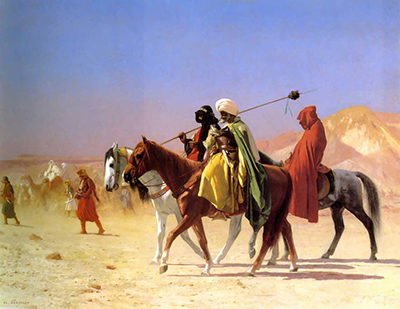Arabs Crossing the Desert by Jean-Leon Gerome was painted in 1870. The oil on panel measures 41 x 56 cm and is signed J.L. Gerome in the lower left-hand corner. It was in private ownership as part of the Najd Collection and on long-term loan to The Metropolitan Museum of Art in New York between November 2007 and October 2016. The work was auctioned by Sothebys in October 2019. Catalogued as Riders Crossing the Desert it was sold to an unknown bidder for over 3 million pounds.
In 1868 Gerome visited the Sinai desert in Egypt, a journey which likely inspired this work. The picture features three horse riders in traditional Bedouin dress. The tribesmen appear in profile in the foreground, travelling towards the left of the frame from a viewer’s perspective. The horses walk across a hot sandy desert under a clear blue sky,riding away from a rocky mountainous background. In the mid-ground there are many more travellers, on foot with two riders on camels.
The three riders in the foreground are on Arabian horses. The central horse is chestnut with four white fetlocks and a white snip and star on its head. Its rider is a grey-bearded old man, with a white turban. He wears a full-length yellow-gold tunic, with a pea-green cape emblazoned with a white symbol on the back. He holds the reins in his right hand. A wide brown leather scabbard containing a silver-coloured sword is strapped to the front of his body. In profile, the rider stares straight ahead.
Behind this rider, is a white Arabian horse. Its head is slightly in front of the chestnut horse’s head. It wears a green, red and gold coloured bridle and breastplate in the Arabian style. The male rider wears a full-length red tunic with a black cape drawn over his head, almost covering his face. The head-covering is secured with gold braid. The rider holds the reins in his left hand. In his raised right hand he holds a long spear, resting on his shoulder. It's decorated with blue ribbon and brown feathers.
The third horse brings up the rear. It is dapple grey and only its rear haunches can be seen. The rider is completely obscured by a full-length red cape and hood.
The work evokes a purposeful journey across unforgiving arid terrain. Whether the weaponry is for defence or attack is unclear.




